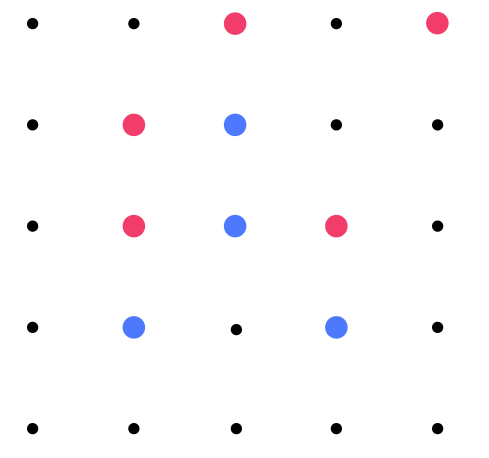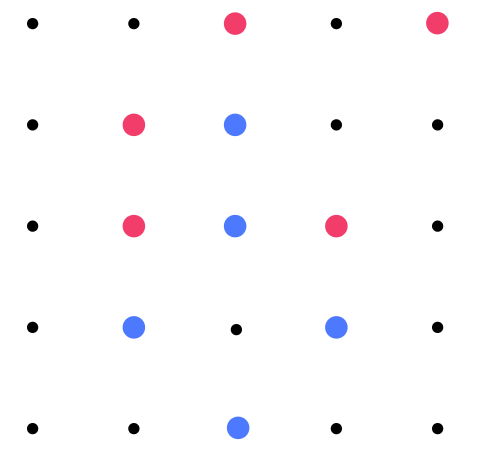Skip over navigation
Players take it in turns to click on a dot on the interactive grid. The first player's dots will be blue and the second player's (or computer's) will be red. The winner is the first to have four dots of their own colour that can be joined by straight lines to form a square.
Have a go at playing the game a few times against the computer to get a feel for it.
Here is a picture taken part-way through a game. It is blue's turn next.

Where would you go if you were the blue player?
Click on the 'Show' button below to see which dot the blue player chose.
Are you surprised?
Why do you think the blue player made that move?

This problem will present many learners with something unexpected, thereby capturing their curiosity and providing a context in which to consolidate their knowledge of properties of squares.
Once you feel they have got the idea of the game, show the group the first image, explaining that it is blue's turn to go. Give them a few moments of individual thinking time to consider what they would do if they were the blue player. Invite them to discuss their thoughts with a partner.
Bring everyone together again and explain that you are going to show them the game after blue had taken his/her next turn. Try not to say any more before revealing the image. (You may need to check that everyone has noticed which dot has been chosen.) Listen and watch out for learners' reactions. You could choose one or two students to share why they were surprised by what they saw.
Give time for pairs of learners to talk about why the blue player chose that dot. In a plenary you could invite some pairs to explain how they know that a square has been formed by the blue player. Try to discourage use of the word 'diamond' to describe a tilted square. You may want to find something that is square shaped e.g. a square piece of paper and physically orientate it in different ways to make the point that it does not stop being a square if it is not held with horizontal and vertical sides.
Which dot did the blue player select?
Why do you think s/he chose that spot?

Or search by topic
Number and algebra
Geometry and measure
Probability and statistics
Working mathematically
Advanced mathematics
For younger learners
Square Surprise
Age 5 to 11
Challenge Level 





- Problem
- Getting Started
- Student Solutions
- Teachers' Resources
Square Surprise
This problem is based on the game Square It, which you can find in Seeing Squares.Players take it in turns to click on a dot on the interactive grid. The first player's dots will be blue and the second player's (or computer's) will be red. The winner is the first to have four dots of their own colour that can be joined by straight lines to form a square.
Have a go at playing the game a few times against the computer to get a feel for it.
Here is a picture taken part-way through a game. It is blue's turn next.

Where would you go if you were the blue player?
Click on the 'Show' button below to see which dot the blue player chose.
Are you surprised?
Why do you think the blue player made that move?

Why do this problem?
This problem will present many learners with something unexpected, thereby capturing their curiosity and providing a context in which to consolidate their knowledge of properties of squares.Possible approach
Use the interactive to play a few games of Square It with the whole class playing against you or the computer. The aim at this point is simply for learners to become familiar with the rules of the game rather than necessarily beginning to think about possible strategies for winning.Once you feel they have got the idea of the game, show the group the first image, explaining that it is blue's turn to go. Give them a few moments of individual thinking time to consider what they would do if they were the blue player. Invite them to discuss their thoughts with a partner.
Bring everyone together again and explain that you are going to show them the game after blue had taken his/her next turn. Try not to say any more before revealing the image. (You may need to check that everyone has noticed which dot has been chosen.) Listen and watch out for learners' reactions. You could choose one or two students to share why they were surprised by what they saw.
Give time for pairs of learners to talk about why the blue player chose that dot. In a plenary you could invite some pairs to explain how they know that a square has been formed by the blue player. Try to discourage use of the word 'diamond' to describe a tilted square. You may want to find something that is square shaped e.g. a square piece of paper and physically orientate it in different ways to make the point that it does not stop being a square if it is not held with horizontal and vertical sides.
Key questions
Which dot would you choose if you were blue? Why?Which dot did the blue player select?
Why do you think s/he chose that spot?
Possible extension
Children can tackle the task Seeing Squares, which invites them to investigate how to develop a winning strategy for the game.Possible support
Some children may want to use this sheet of the two images so they can convince themselves that blue has got a square, perhaps by cutting and/or measuring.You may also like
Geoboards
This practical challenge invites you to investigate the different squares you can make on a square geoboard or pegboard.

